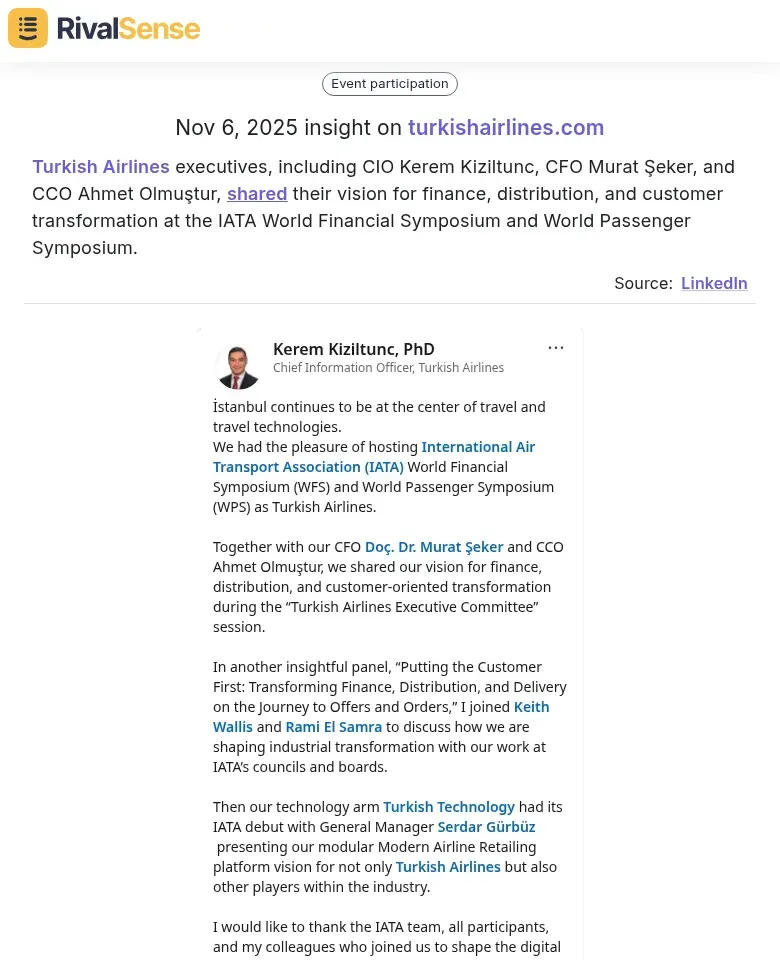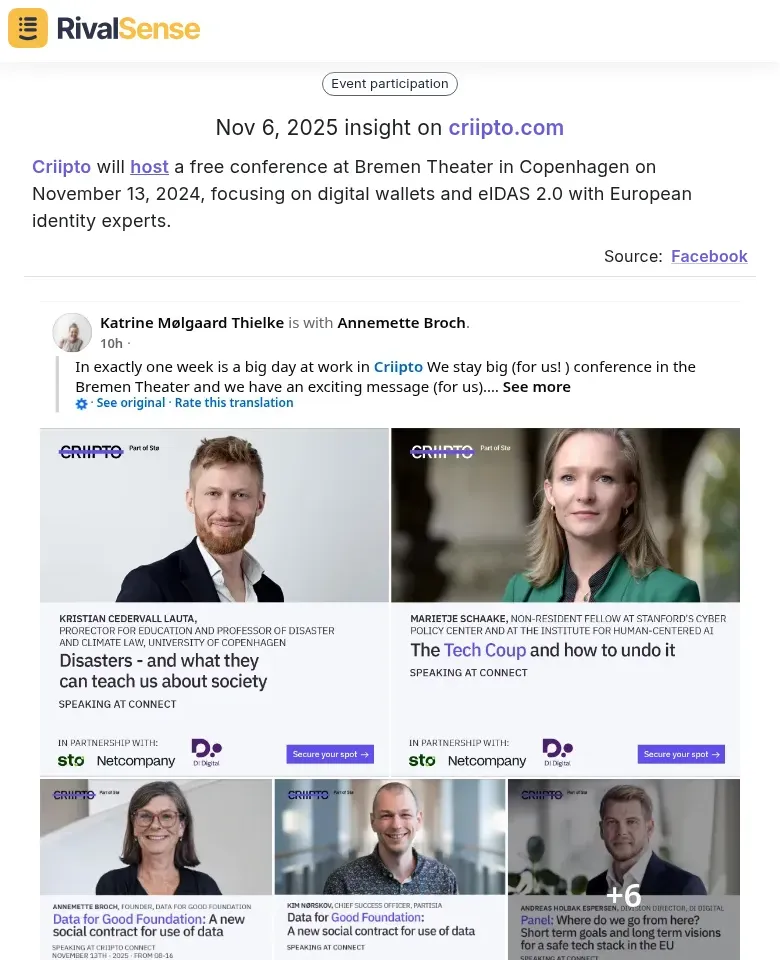Boost Productivity: Track Competitor Events for Brand Perception Insights
Competitor events are powerful brand perception drivers that directly shape market positioning and customer expectations. When rivals host conferences, webinars, or product launches, they're not just showcasing features—they're crafting narratives about innovation, customer focus, and industry leadership. By systematically tracking these events, you gain invaluable insights into how competitors want to be perceived and where your own brand strategy may have gaps.
Practical steps to get started:
- 📅 Create a competitor event calendar tracking all major industry gatherings
- 🔍 Analyze event messaging, speaker lineups, and attendee engagement
- 📊 Compare competitor positioning against your own brand narrative
- 🎯 Identify recurring themes that signal emerging industry trends
This intelligence helps you anticipate market shifts, refine your messaging, and ensure your brand remains relevant and differentiated. The key is turning event observations into actionable competitive advantages.
Strategic Insights from Executive Participation in Industry Events
Executive participation in industry events reveals critical strategic insights about competitor priorities and market positioning. Tracking which competitors secure keynote or panel roles can signal thought leadership and strategic focus areas. For example, if a rival's CTO consistently speaks on AI integration, they're likely investing heavily in that technology.
For instance, RivalSense provided this insight: Turkish Airlines executives, including CIO Kerem Kiziltunc, CFO Murat Şeker, and CCO Ahmet Olmuştur, shared their vision for finance, distribution, and customer transformation at the IATA World Financial Symposium and World Passenger Symposium.  This type of insight is valuable because it highlights the strategic narratives competitors are building around key business functions, allowing you to align or differentiate your own executive engagements.
This type of insight is valuable because it highlights the strategic narratives competitors are building around key business functions, allowing you to align or differentiate your own executive engagements.
Practical steps:
- Create a competitor event tracking spreadsheet with columns for event name, executive role, presentation topics, and key messages
- Monitor industry conference agendas 3-6 months in advance
- Note recurring themes across multiple competitor presentations
- Compare how different companies position similar technology solutions
- Document language and positioning differences in executive bios and session descriptions
Key insight: The frequency and seniority of executive participation often correlates with market expansion plans. Companies preparing for new market entries typically increase their leadership visibility at relevant industry forums. Track this pattern to anticipate competitive moves before official announcements.
Sponsorship Strategies: What Event Sponsorship Reveals About Brand Positioning
Event sponsorship choices provide deep insights into competitor target audiences and market focus. Analyzing which events they sponsor and at what level can reveal their brand positioning and investment priorities. For example, a fintech company sponsoring tech conferences likely targets B2B decision-makers, while higher sponsorship tiers indicate aggressive market capture efforts.
Consider this RivalSense insight: Sprout Social sponsors DMWF Europe 2025 on November 25-26 in Amsterdam.  This insight is valuable as it shows where competitors are allocating marketing budgets to build visibility, helping you identify potential gaps or opportunities in your own sponsorship strategy.
This insight is valuable as it shows where competitors are allocating marketing budgets to build visibility, helping you identify potential gaps or opportunities in your own sponsorship strategy.
Steps to analyze sponsorship strategies:
- List competitor-sponsored events and sponsorship tiers.
- Assess audience demographics and alignment with your goals.
- Compare to your own event participation to identify misalignments.
- Prioritize high-impact sponsorships that match your target market.
This approach boosts ROI by leveraging competitor strengths and weaknesses in event marketing.
Content and Messaging Insights from Competitor-Hosted Events
Competitor-hosted events are treasure troves for understanding their strategic messaging and market positioning. By analyzing the content, speakers, and themes, you can uncover their focus areas and how they aim to influence the industry. This intelligence helps you refine your own messaging and identify emerging trends.
Here's an example from RivalSense: Criipto will host a free conference at Bremen Theater in Copenhagen on November 13, 2024, focusing on digital wallets and eIDAS 2.0 with European identity experts.  This insight is valuable because it reveals the specific topics and expertise competitors are highlighting, allowing you to anticipate regulatory or technological shifts and adjust your strategy accordingly.
This insight is valuable because it reveals the specific topics and expertise competitors are highlighting, allowing you to anticipate regulatory or technological shifts and adjust your strategy accordingly.
Extract Key Messaging Themes: Analyze conference agendas and session topics to identify recurring themes. For example, if a competitor consistently features AI integration sessions, they're likely positioning themselves as AI leaders. Create a spreadsheet tracking topics, speaker expertise, and audience targeting across multiple events.
Identify Emerging Focus Areas: Monitor event content for new technology trends or regulatory discussions. If competitors suddenly add blockchain compliance workshops, it signals market shifts. Track these changes quarterly to spot patterns before they become mainstream.
Establish Authority Mapping: Note which domains competitors claim expertise in through event branding and speaker selection. If they feature industry regulators as keynote speakers, they're building credibility in compliance.
Practical Checklist:
- ✅ Subscribe to competitor event newsletters
- ✅ Download and analyze presentation decks
- ✅ Track speaker backgrounds and affiliations
- ✅ Monitor Q&A sessions for audience concerns
- ✅ Compare event messaging across quarters
This approach reveals not just what competitors say, but how they strategically position themselves in the market landscape.
Practical Framework for Tracking and Analyzing Competitor Events
Establishing a systematic competitor event tracking framework is essential for uncovering consistent brand perception insights. This involves setting up monitoring tools and creating a centralized system for data collection and analysis. By doing so, you can transform scattered observations into actionable intelligence.
First, set up automated monitoring using tools like Google Alerts, social media trackers, and RSS feeds for competitor websites and industry news. Create a centralized calendar—using Google Sheets or project management software—to log all events, including dates, locations, themes, and attendee demographics. For example, track a rival's webinar series to analyze their messaging shifts over time.
Next, develop a structured analysis approach. Categorize events by type (e.g., webinars, conferences, product launches) and assess key metrics: speaker profiles, sponsorship levels, and audience engagement (e.g., social media mentions, post-event surveys). Use this data to identify patterns, such as recurring topics that highlight strategic priorities or gaps in your own outreach.
Integrate findings into your competitive intelligence workflow by scheduling monthly reviews. Compare event insights with other data sources—like pricing changes or feature updates—to build a holistic view of competitor strategies.
Tips for Success:
- 👥 Assign team roles for data collection and analysis
- 📋 Create checklists for pre- and post-event monitoring to ensure consistency
- 🔄 Schedule regular reviews to update your strategy
This practical approach turns event tracking into actionable intelligence, boosting productivity and informing your brand's positioning.
Turning Insights into Action: Applying Event Intelligence to Your Strategy
Transforming competitor event insights into strategic advantages requires a proactive and systematic approach. By applying the intelligence gathered, you can refine your strategies and stay ahead in the competitive landscape. Here's how to make the most of your findings.
-
Refine Your Event Participation Strategy: Analyze which competitor events generate the most buzz. If they consistently dominate industry conferences, identify underutilized niche events where you can establish thought leadership. Create a checklist: track competitor speaking slots, booth locations, and attendee engagement metrics to optimize your own event calendar.
-
Enhance Brand Positioning: Study competitor messaging themes across events. If they emphasize innovation, counter with reliability-focused campaigns. Use event intelligence to identify gaps in their narratives—for example, if they overlook customer success stories, make that your centerpiece. Tip: Monitor post-event sentiment to adjust your messaging in real-time.
-
Identify Proactive Opportunities: Spot patterns in competitor event timing (e.g., product launches at Q4 trade shows). Use this to preempt their moves—launch complementary features or partnerships ahead of their announcements. Practical step: Maintain a competitor event calendar to anticipate market shifts and seize first-mover advantages.
Ready to Elevate Your Competitor Tracking?
To streamline your competitor event monitoring and gain weekly insights into launches, pricing, partnerships, and more, try RivalSense for free. Get your first competitor report today at https://rivalsense.co/ and transform how you track the competition.
📚 Read more
👉 Leveraging Competitor Personnel Changes for Strategic Advantage
👉 Leveraging Competitor Insights for Content Marketing Advantages
👉 HR Consulting's Competitive Edge: Unlocking Growth Through Rival Analysis
👉 How Databricks' OpenAI Deal Drove Competitors to Accelerate AI
👉 Best Practices: Facebook Competitor Insights for Award Monitoring
